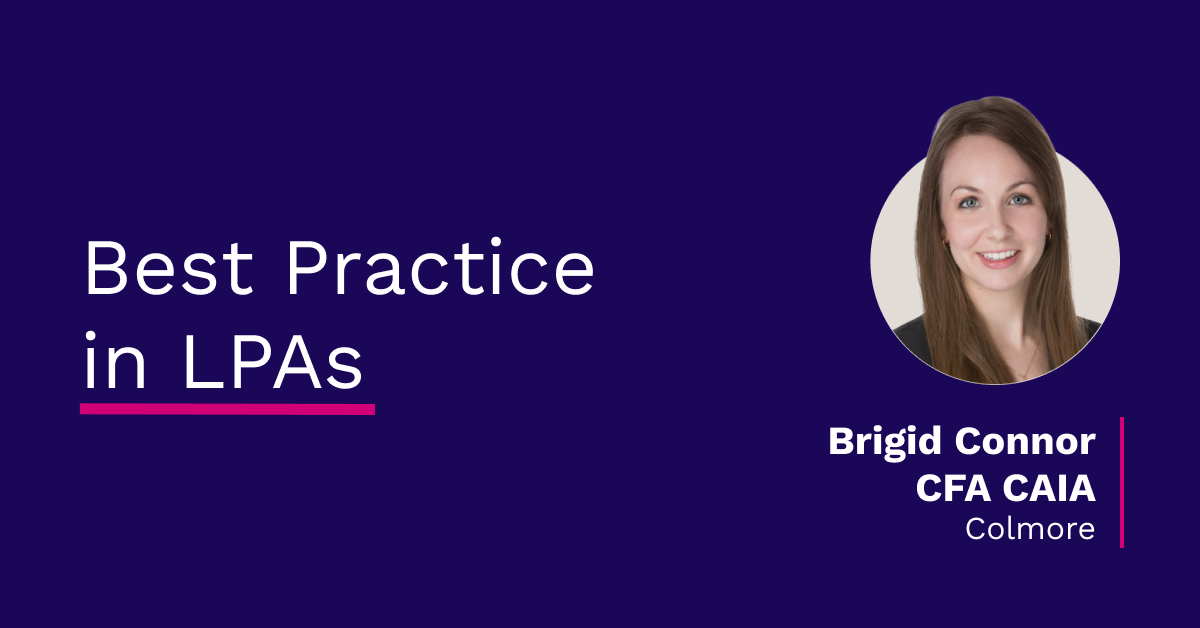Fund due diligence for private capital

Due diligence (DD) is a vital part of an investor’s decision-making about a private capital fund. It can also make a big difference when it comes to the long-term relationship with a fund manager.
For limited partners (LPs), fund DD can uncover new risks and opportunities, as well as identifying key negotiation points. For general partners (GPs), the process can demonstrate transparency, enhance investor confidence, and strengthen trust.
In Preqin’s recent report Manager Selection & Fund Terms: Due Diligence Terms, Brigid Connor, CFA, CAIA, Product Development & Research at Colmore, takes an in-depth look at the benefits of a rigorous review of the Limited Partnership Agreement (LPA). Shaun Beaney, Editor, Preqin First Close, asked Brigid about benchmarking, best practice, and for top tips for effective fund DD.
In layperson’s terms, what’s the purpose of DD?
I’d say any person on the street would be familiar with due diligence. When you buy a house or look at an apartment, you want to know what you’re getting into. You want to know what you have to pay, what you’re going to get. Are you comfortable with the risks? There are pros and cons with everything. You’re never going to find a perfect house or a perfect deal. You have to decide what things you can live with. What thresholds are you unwilling to cross? Ultimately, in due diligence you want to minimize surprises and be comfortable with the risk-return ratio.
Tell us a little about Colmore’s work on pre-investment fund DD.
A lot of our clients are LPs, such as pension funds and sovereign wealth funds. They have a lot of governance and oversight. They really want to make sure they’re dotting their i’s and crossing their t’s. We help by providing benchmarking and best-practice guidance.
There are good opportunities for GPs as well. In the pre-investment DD process, they want to fundraise competitively. To attract high-quality LPs, they benefit by knowing market rates and best practices.
GPs and LPs benefit from transparency in fee terms, which in turn contributes to market efficiency. That leads to lower transaction costs, and, by extension, higher net returns.
What are the most common risks you address?
There are probably two. The first one is ambiguity in the LPA. It’s a large document – frequently 100 pages, sometimes more, sometimes less. There are a lot of terms, naturally. But even for a given term, such as ‘investment proceeds’, there can be a different definition in each LPA. You have to look closely at the definition because you’ll find nuances there with financial-risk implications.
Another big risk is unknown unknowns. You’d think that in a hundred pages of LPA text there would be everything you could possibly think of. In practice, a lot may be left out. The critical part is understanding the context. That’s where the benchmarking comes in – comparing strategy, fund size, geography, or vintage. The better you understand the market, the more you minimize unknown unknowns.
Are you addressing different risks now, in tougher times in the market?
One of the hallmarks of private markets is lagged and smoothed performance. Similarly, LPA terms change slowly. This reflects two things: the GP’s operations; and the law firm’s advice. Neither is likely to change dramatically in a short period of time. For example, I’ve charted management fees from vintages 2010 to 2023 against management fee rates. The trends were slow and steady, mostly downward. In some cases, the lower fee rate was offset by routing fees that were typically covered by management fees through partnership expenses.
How do you address potential performance when there’s so much economic and financial uncertainty?
We model performance based on our own historical data and market performance drivers. We model a variety of scenarios. We have a base case, a low-cost case, a high-cost case, and a benchmark case. These scenarios are designed to account for 87% of outcomes. If you’re projecting outcomes between 10 and 12 years into the future, you want to be prepared for a variety of scenarios.
What about incentive allocations, such as hurdle rates and carried interest?
We show in the Manager Selection & Fund Terms: Due Diligence Terms report that there are different incentive structures by strategy. For hurdle rates, for example, it’s important to know that if you’re looking at a private debt fund, you shouldn’t be surprised to have a lower hurdle rate than 8%. This reflects a relatively lower risk-adjusted return in private debt. For incentive allocations, the rate that comes to mind is 20%, but for VC, on average, it’s higher, and for real estate, on average, it’s lower. These reflect the economics and risk-return profiles of the various strategies and asset classes.
What would your top three tips be for LPs undertaking fund due diligence?
I’d say three things: detail; context; relationship.
Detail. Dig into it. Make sure you understand the fine print. If you do that, you’ll probably find something worth negotiating. For example, when does the management fee end? Sometimes that’s after year ten or the initial term. Sometimes it goes into the extension period. You might negotiate that down, or even negotiate it away.
Context. That’s where you look at the peer group, based on strategy, fund size, geography, or vintage, so you have the context. You can understand what a reasonable comparison is. That’s the beauty of benchmarking and peer-group statistics.
Relationship. There are things that you’re not going to find by looking solely at the LPA. If you have questions, you’re going to ask the GP. How are those interactions? Does the GP give you the information you need? Are they receptive to negotiation of terms? It’s not a transaction, so are you happy with the potential 10- to 12-year relationship? You need alignment. You need trust.
Shaun Beaney is Editor of Preqin First Close, the essential newsletter for the global alternatives market. It’s quick, easy, and free to subscribe here.
Find out how Colmore’s FAIR fee validation service can help you track, validate, and benchmark fees in a simpler, more cost-effective way.

